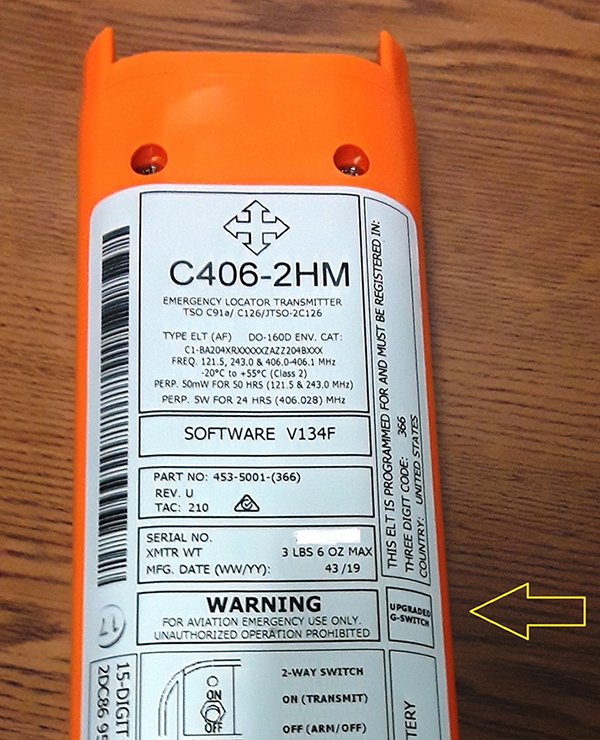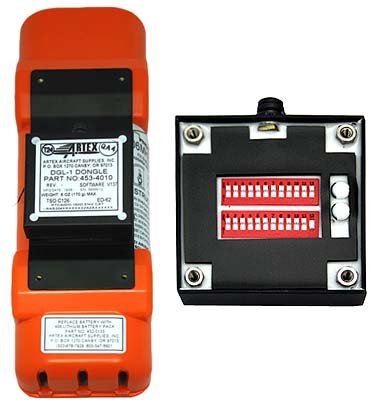 will be closed December 24th - January 2nd for the Holidays.
will be closed December 24th - January 2nd for the Holidays.
Regular business hours will resume on Monday, January 5th.
AOG Services are available.
| Part #: | |
|---|---|
| Model: | C406-2HM |
| Desc: | ELT (406 MHz) - Dual Frequency - Helicopter Model |
| OEM: | ACR/Artex |
| NSN: | |
|---|---|
| Sched-B: | 8525508040 |
| ECCN: | |
| Cage Code: | 18560 |
 Select part number above to view pricing and availability.
Select part number above to view pricing and availability.
| Price | Condition | Availability | Stock Info | |
|---|---|---|---|---|
| Price | Cond. | Avail. | Stock Info | |
| $7,700.00 | NEW OUTRIGHT | 1 IN STOCK |
Serial #: 210-15844 [Details]
|
| Price | Condition | Availability | Stock Info | |
|---|---|---|---|---|
| Price | Cond. | Avail. | Stock Info | |
| $6,750.00 | NEW OUTRIGHT | REQUEST LEAD TIME |
|
| Price | Condition | Availability | Stock Info | |
|---|---|---|---|---|
| Price | Cond. | Avail. | Stock Info | |
| $8,135.00 | NEW OUTRIGHT | 1 IN STOCK |
Serial #: 210-15604 [Details]
|
| Price | Condition | Availability | Stock Info | |
|---|---|---|---|---|
| Price | Cond. | Avail. | Stock Info | |
| REQUEST | NEW OUTRIGHT | REQUEST LEAD TIME |
|
| Price | Condition | Availability | Stock Info | |
|---|---|---|---|---|
| Price | Cond. | Avail. | Stock Info | |
| $9,450.00 | NEW OUTRIGHT | REQUEST LEAD TIME |
|

In order to ship hazardous materials (HAZMAT) the shipper must have HAZMAT certified personnel. SEA will provide HAZMAT paperwork along with proper packaging and labeling for shipments directly to our customers. If the shipment must be sent to another location such as a freight forwarder, SEA will provide the HAZMAT paperwork to the original ship to address only. Please contact your freight forwarder prior to ordering to verify that they are HAZMAT certified. SEA is not responsible for issues that arise if your freight forwarder does not have HAZMAT qualified personnel.
SPECIFICATIONS
| Operating Frequencies: | 406.025 MHz ± 2 kHz Biphase L (16K0GID), 121.5 & 243.0 MHz ± 0.005% (A3X) | Output Power: | 406 MHz: 5W ± 2dB (520ms/50sec) for 24 hours @ -20°C 121.5/243.0MHz: 100mW min (+20dBm) for 50 hours @ -20°C |
| Output Connector: | BNC Female (121.5/243.0) TPS Female (406MHz) | Activation: | Automatic by 4.5ft/sec G-Switch or Manual |
| Battery: | 5 year Lithium | Temperature: | Operating: -20°C to +55°C Storage: -55°C to +85°C |
| Self Test: | G-Switch enabled 406MHz Power Antenna/Coax Connection Position Data Present Low Battery | Remote Control: | ON/OFF/RESET |
| Antenna: | Rod (110-320)(<350KTS) Blade (110-337)(Mach I) | Mounting Hardware: | Mounting Tray P/N: 452-5050 Protective Top Cover P/N: 452-3052 End Cap P/N: 452-5052 |
| Other Parts: | Coax cable Buzzer (to alert ground crew of accidental activation) | Weight: | ELT Transmitter: 3lb 5.8oz Max Mounting Tray: 7 oz Protective Top Cover: 6.7oz End Cap: 3.8oz Total Weight: 4lb 11oz |
| Measurements: | ELT Transmitter with Mounting Hardware installed: 11.74"L x 3.9"H x 3.82"W |
| Part Number: | Model: | Description: |
|---|---|---|
| 453-5000 | C406-2 | ELT Transmitter Only (Main Assembly) |
| 453-5001 | C406-2HM | Helicopter ELT Transmitter Only (Main Assembly) |
| 455-5000* | C406-2 | ELT Base Pack List - contains transmitter & mounting hardware only |
| 455-5001* | C406-2HM | Helicopter ELT Base Pack List - contains transmitter & mounting hardware only |
| 455-5010* | C406-2 | Complete ELT System with Rod Antenna (110-320) |
| 455-5011* | C406-2 | Complete ELT System with Blade Antenna (110-337 Hi-Speed) |
| 455-5012* | C406-2HM | Complete Helicopter ELT System with Rod Antenna (110-320) |
| 455-5013* | C406-2HM | Complete Helicopter ELT System with Blade Antenna (110-337 Hi-Speed) |
| 455-5022* | C406-2 | ELT with mounting accessories (hardware not included) |
| 455-5028* | C406-2 | Complete ELT System with Blade Antenna (110-337 Hi-Speed) & Gray Military Remote Switch |
| 455-5029* | C406-2 | Complete ELT System with Rod Antenna (110-320) & Gray Military Remote Switch |
| 455-5030* | C406-2 | Complete ELT System with Blade Antenna (110-333) |
| 455-5031* | C406-2 | Complete ELT System with Rod Antenna (110-323 Dual Input) |
| 455-5032* | C406-2 | Complete ELT System with Whip Antennas (110-324 & 110-329) |
| 455-5035* | C406-2 | Complete ELT System with Blade Antenna (110-337 Hi-Speed) & Black Military Remote Switch |
| 455-5036* | C406-2 | Complete ELT System with Blade Antenna (110-337 Hi-Speed), 15' co-ax Cable & Black Military Remote Switch |
| 455-5037* | C406-2 | Complete ELT System with Blade Antenna (110-337 Hi-Speed), 15' co-ax Cable & Gray Military Remote Switch |
| 455-5049* | C406-2 | Complete ELT System with Rod Antenna (110-320) & 10' co-ax Cable |
NSN: 5826-01-561-2911
| Price | Condition | Status |
|---|---|---|
| $7,700.00 | NEW OUTRIGHT | 1 IN STOCK |
| Price | Condition | Status |
|---|---|---|
| $8,135.00 | NEW OUTRIGHT | 1 IN STOCK |
NSN: 1680-00-562-5270
| Price | Condition | Status |
|---|---|---|
| $6,750.00 | NEW OUTRIGHT | REQUEST LEAD TIME |
| Price | Condition | Status |
|---|---|---|
| REQUEST | NEW OUTRIGHT | REQUEST LEAD TIME |
| Price | Condition | Status |
|---|---|---|
| $9,450.00 | NEW OUTRIGHT | REQUEST LEAD TIME |
Click on a question below to see the answer. If you have a question about this model that is not answered below, please contact questions@seaerospace.com
Long messaging operates with a nav interface. If you have a nav interface of some sort, then short messaging programming should be chosen.
Long messaging transmits longtitude and latitude. Short messaging does not.
In relation to NE (New) parts, many OEMs change their prices and availability without any notice to dealers or the industry. Therefore, through the REQUEST or RFQ indication, we ask that customers contact us for the most accurate price and availability.
In relation to SV & OH parts, the used parts aftermarket in the aviation industry is not an infinite supply. It is a dynamic, constantly changing market that is significantly affected by and susceptible to highs and lows in supply and demand. Therefore, although we attempt to, at times, we are unable to predict the exact moment when an item may be available. Once again, through the REQUEST or RFQ indication on our website, we ask that customers contact us for the most current and accurate price and availability.
The only indication that new ACR/Artex ELTs have the upgraded G-switch as detailed in SB1000 is the "UPGRADED G-SWITCH" box on the identification plate. Please see image for reference.

Virtually all 406 MHz beacons incorporate a self-test mode of operation. Standard Self-Tests of beacons usually involve pressing a button or lifting a lever on the beacon and holding it for a few seconds. This usually results in the beacon flashing an LED or Strobe and/or creating an audible sound that indicates that the internal circuitry of the beacon is functioning correctly. You should always carefully follow the beacon manufacturer's instructions when carrying out a self-test as it is possible to get false results or inadvertently trigger a false alarm if perform the self-test incorrectly. If the beacon fails, then you should contact the beacon manufacturer or an appointed service agents for further advice and instructions.
Emergency Locator Transmitters (ELTs) are distress radio beacons which transmit location information about aircraft directly to Search and Rescue (SAR) forces letting them know that the owner is in grave and imminent danger.
A UIN is a Unique Identifier Number that is programmed into each beacon at the factory. The UIN number consists of 15 digit series of letters and numbers that make up the unique identity of the beacon. The UIN is on a white label on the exterior of the beacon. The UIN is also referred to as the Hex ID.
You should check the local regulations of any place you plan to visit with your beacon. Some countries require you to have a radio license and some countries even have restrictions on the use of beacons. However, if it's a true emergency, then you should always activate your beacon.
Yes, the C406-2 & C406-2HM ELTs are a direct replacement for the 110-406 Series. According to the Discontinuance letter released from Cobham, the 110-406 series product line was discontinued on 12/31/01. Artex planned to continue providing battery packs and repairs until 2008. You can view the letter here.
According to Artex (now Cobham) the C406-2/2HM ELTs are a direct replacement in form, fit & function. Additionally, the ME-406 series is suitable for General Aviation and Light Helicopter applications. These ELTs are certified to the requirements of FAA TSO C126 and ETSO-2C126.
View the C406-2, C406-2HM, and ME-406 Series product pages for more detailed information.
If a problem is detected in the ELT, the LED will produce a coded signal. The LED will flash in order of importance with approximately .5 to 1 second pulse between each coded signal if multiple errors are present. The coded signal and related problems are as follows:
Southeast Aerospace has full bench test and programming capabilities for all Artex (Cobham) ELTs. Please contact the SEA Service Dept for any ELT service questions.
 . These Russian words translate to "Space System for the Search of Vessels in Distress".
. These Russian words translate to "Space System for the Search of Vessels in Distress".
